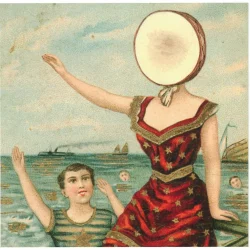 It takes quite an effort to be an especially lazy person; easier to just be typically lazy. So, in selecting this album as a classic of Americana, I’ll demonstrate my own typically lazy approach by straightaway steering you towards Diccon Johnston’s excellent piece from a couple of years ago, in the AUK series, ‘Americana A to Z’. It’s a beautifully written and comprehensive article on the band and this album in particular, and covers a lot of the background and broader context. But let me throw in my two cents regarding why I think it deserves its place as a classic Americana album.
It takes quite an effort to be an especially lazy person; easier to just be typically lazy. So, in selecting this album as a classic of Americana, I’ll demonstrate my own typically lazy approach by straightaway steering you towards Diccon Johnston’s excellent piece from a couple of years ago, in the AUK series, ‘Americana A to Z’. It’s a beautifully written and comprehensive article on the band and this album in particular, and covers a lot of the background and broader context. But let me throw in my two cents regarding why I think it deserves its place as a classic Americana album.
Neutral Milk Hotel was formed in Ruston, Louisiana, by songwriter Jeff Mangum. He’d been part of a successful teenage enterprise, releasing home-recorded cassettes that eventually evolved into the loose, anarchic music collective, Elephant 6 Recording Company. ‘In the Aeroplane Over the Sea’ was the second Neutral Milk Hotel album and when it was released in 1998, it wasn’t especially well-received, attracting some lukewarm reviews but, crucially, it connected with a few very, very committed fans who were just beginning to realise that the internet could allow them to share their love of this obscure, and quite weird and wonderful album. As a direct result, in the years after its release, the album came to be recognised by virtually every major indie music magazine, website or blog as a five star classic of lofi and indie-folk. However, despite the widespread critical re-evaluation ‘In the Aeroplane Over the Sea’ remains deeply polarising. Haters keep on hating.
To be fair, the first thirty seconds of ‘In the Aeroplane Over the Sea‘ will probably have most people scrabbling for the stop button and murmuring quiet expletives under their breath. But not so fast. Even die-hard fans of the album admit to having taken years to appreciate it properly, eventually overcoming their initial feelings of loathing or just their bemusement that they’ve been practically forced to listen to this distorted mess by some impassioned friend or acquaintance.
On the face of things, it’s hard to pin down what makes the album so affecting. The songs were written and first performed on an acoustic guitar. No fancy tunings or complex chords, just a mix of lusty, impassioned strums or gentle and delicate strums. There’s a real mix of instruments involved, including some boisterous horn arrangements and even the unearthly wails of bowed saws. The vocal melodies over these uncomplicated chord progressions don’t sound like your typical melodies, and there are sometimes hard-to-pin-down shades of Levantine or Eastern European influences. If that’s not enough to put you off yet, lyrically the album has a deliberately obscured conceptual subtext. Most of the songs relate in some way to a dream Mangan had of an imagined romance with Anne Frank while she’s trapped in her intense and claustrophobic domestic world hiding from the Nazis in an attic with the rest of her family. To complicate things further, there’s a lot of non-ironic impassioned religious imagery in the songs. Still hanging in there?
With a few basic chords, unconventional melodies and disorientating and opaque lyrics, surely a nice straightforward production job would be required to make the best of it, no? No. There’s more distortion on ‘In the Aeroplane Over the Sea’ than on most punk albums. It’s probably one of the most distorted albums of all time. There’s distortion everywhere and it’s deliberate. Mangan and the band worked with their initially reluctant producer, Robert Schneider, to create a bespoke fuzz-like distortion that would go across the entire instrumentation: acoustic guitar, drums, horns, accordion, banjo, bass, even the saw. Schneider adapted a valve compressor, overloading it and other elements of each signal chain to create the warm distorted tones that are across the whole album. The work of a bumbling amateur? Not at all. It was the painstaking work of a producer who, as well as being a musician himself, also has a PhD in mathematics, lecturing in the subject at the University of Georgia.
So is it really an Americana classic? I think so. Nearly twenty-five years after its inauspicious release on a small indie label, and only backed by a brief but frenzied tour of small venues prior to Mangan calling time on the band and effectively withdrawing from the music industry, the album has sold hundreds of thousands of copies. It continues to sell year after year creating new waves of heavily invested fans. For sure it’s on the outer edges of the Americana genre, but it remains a significant landmark album, cited by bands like Arcade Fire and The Decemberists as a major influence. Early in his career, in an interview for Uncut, Conor Oberst said of it, “It made me want to make better music. That was the most beautiful sound I’d ever heard. Life was different after hearing that. It influenced what we were doing at the time.” He’s not alone in that. Many other younger Americana artists were inspired by that impassioned roar of lofi folk-thrash, improbably married to delicate instrumentation and obscure but heart-wrenchingly beautiful lyrics and imagery.
It’s still one of my favourite albums. My wife rolls her eyes and grimaces whenever I try and play it in the car. Pick your camp.


